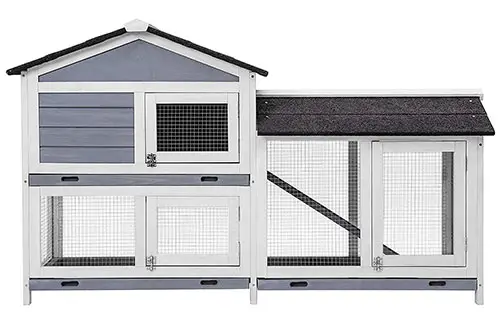Disclosure: We may earn money or products from the companies mentioned in this post.

Over the decades my family and friends have kept pet bunnies in countless settings including apartments. From our shared experiences, I’ve gathered everything you need to know about keeping pet rabbits in apartments.
Let’s start with the basics.
Rabbits make great apartment pets because they are small and quiet, but they are going to need some space in your apartment for their rabbit cage and a larger play area. You also need to have realistic expectations regarding the not insignificant time and energy that a pet rabbit is going to require.
A pet rabbit takes about as much space as a dog and about as much time as a cat, making them a nice compromise for apartment dwellers.
For example, a pet bunny doesn’t need to be walked like a dog, but it will have a litter box like a cat.
10 Things To Consider Before Getting A Rabbit For An Apartment Pet
#1 – Identify Your Rabbit Sitter Before You Get A Bunny
Because your new pet bunny doesn’t need daily walks, she will be fine for a few days on her own if you are headed out of town. But she will need to be fed, watered, and have her litter box cleaned every few days.
In addition, she’ll need some love. Rabbits are social animals and your bunny will be very lonely if she’s used to cuddling with you daily. To that end, make sure that your bunny sitter has time to bond with your pet before you need them to take care of your rabbit alone.
#2 – Have A Plan To Feed Your Rabbit Fresh Veggies and Greens
While your rabbit will eat pellets made specifically for rabbits, to thrive she will need fresh vegetables and greens to supplement those pellets.
Do you shop at a grocery store where you can get fresh veggies for your rabbit? If you live off of food delivery, can you have a salad delivered to share with your bunny?
Just think about it ahead of time and have a plan.
#3 – Decide Where Your Bunny Is Going to Live
Apartment dwellers really have three options for housing their pet rabbit.
- A Smaller Cage
- A Larger Hutch
- A Dedicated Room
While a smaller cage fits so much better in a small apartment, you need to think about this choice very carefully.
Your rabbit can live in a smaller cage if it’s a smaller rabbit and if you are going to get your rabbit out to play with her very regularly. Smaller cages should only be considered as an overnight home, and not an all-day place to live.
If you do choose a smaller cage, make sure that your Rabbit Sitter from #1 is a neighbor who can come over daily to give your bunny some time outside of their smaller cage.
You’ll also want to consider if the cage is going to sit the floor or if you are going to want it on a small table so it’s easier to get your bunny out, feed, and clean the cage. { See a Small Cage on Amazon >> }
A larger hutch has not only a sleeping space but a play area for your rabbit.
These are a much nicer choice for a larger rabbit or for a bunny who is going to be on her own for longer periods of time.
Unfortunately, these take more space than a cage and are more expensive. However, you won’t need a table to make bunny care easier on your back.
A larger rabbit hutch also makes a wonderful conversation piece for your apartment. If you’ve ever visited friends with a pet rabbit, seeing a bunny in a hutch is a much different experience than seeing a rabbit in a cage.
If it’s within your means and space restrictions, and nice hutch will make having a bunny as a pet a whole different and better experience for you, your bunny, and your friends who visit. { See a Larger Rabbit Hutch on Amazon >> }

Your final choice for living space for your bunny is a dedicated room.
Some people let their bunny free-range through the whole apartment all of the time, but I think that introduces unnecessary stress and danger for your bunny.
A bunny behind a door when it gets opened can get badly hurt, and some bunnies think electrical cords look like twigs that are great to chew on. For those reasons, if you want to free-range your bunny most of the time, I’d encourage you to give them their own bunny safe room.
In a bunny room, they’d still need some kind of box for a burrow (dark bed), but they won’t need a cage or a hutch.
Somethings to consider before choosing this living arrangement for your bunny include:
- You’ll need a baby gate for the doorway.
- You’ll need to litter box train your bunny.
- You’ll need to really make the room bunny safe, paying special attention to electrical cords and narrow spaces your bunny might try to crawl into (make sure that floor air vents are securely covered).
Keep in mind that you will be giving up a spare room, and plan ahead for what you are going to do when you have overnight visitors. Do the visitors get the couch, or will you have a small rabbit cage so your visitor can room with your bunny?
Check out our Recommended Rabbit Gear right here on Rabbitpros.com.
#4 – How Will You Transport Your Bunny?
While you are probably not going to be taking your bunny on walks, you might occasionally have to take her out to visit the veterinarian.
Make sure you have a plan for how you are going to transport your bunny. You will need a small animal carrier. { See one On Amazon >> } and a plan for getting there. Do you have a car? Subway? Bus?
With a good carrier, all of those are fine options, but be sure to plan ahead so you don’t find yourself in an emergency situation without a plan.
#5 – Think About Your Social Life & How A Bunny Fits In
If you a roommate, think about their social life too.
Rabbits are small as a cat, but not as quick as a cat. If there are regularly large gatherings of people in your apartment, you’ll need someplace safe for your bunny to be so she doesn’t get sit on or stepped on.
#6 – Think About Climate
When younger I lived in a number of apartments, and in my experience, not all apartments do a great job keeping temperatures even throughout.
Rabbits are pretty hearty and can handle cold much better than heat. So if you have a room that is colder than the others, that might be a pretty great place to keep your pet rabbit.
On the other hand, if you have a room that gets crazy hot you should keep your rabbit away from that room.
For example, we once lived in an apartment that had three floors in an old house. That top-floor bedroom was hot as Hades in the summer. I’m not sure it was really safe for humans, but I know a rabbit would have died up there in the summer.
#7 – Consider The Litter Box
Your bunny is going to need a place to go to the bathroom.
Most people who keep a bunny in an apartment, get a litter box for their bunny. The upkeep of a rabbit litter box isn’t any more of a chore than a cat litter box, but it is going to need to be cleaned every few days.
However, you are going to have to know where that litter box is going to sit. Ideally, it’s out of the way and out of sight.
A litter box is never an attractive conversation piece, and there will be an odor similar to that of a cat box.
If your bunny is living in a cage or hutch, the decision is easy. You’ll have a small litter box inside their home.
However, if your bunny is in its own room or free-ranging the whole house, give the specific location of the litter box some thought. We like to hide them in a closet or behind an open door.
#8 – Consider The Missed Litter Box
Your bunny is going to occasionally miss the litter box. Sometimes by a few inches, and other times by a room or two.
And these little misses aren’t always an active choice. Rabbits are notorious for making a little mess when startled and even while they are sleeping (maybe they are dreaming of being startled?).
These aren’t big messes or hard to clean up messes, but they are still messes.
Make sure you are aware of and ready for this actuality of living with a rabbit in an apartment.
#9 – Do You Have Other Pets?
If you have a cat or dog, you need to carefully consider how that pet is going to deal with having a rabbit in the apartment.
Rabbits live well with cats and dogs, but not all cats and dogs live well with rabbits.
Just remember that rabbits are prey, and cats and dogs are predators. However, some cats and dogs are more predatory in nature than others. Do you and your other pets have enough discipline to overcome their initial reflexes to chase their new roommate?
#10 – Check Your Lease!
Last but not least, make sure that your lease allows pet rabbits.
It would be heartbreaking to go to all of the efforts and expense of getting a new pet rabbit to only discover that they are not allowed in your lease agreement.
Some apartments do not allow pet rabbits because a bored and unattended bunny can cause significant and expensive damage to the hardwood baseboards and even to the walls of an apartment or home.
There is likely a pet deposit, which will add to the cost of getting a rabbit.
“So, how much is the average total cost of a pet rabbit? The average cost for a pet rabbit is about 50 dollars, but that doesn’t include the cost of a rabbit cage, food, bedding, and other essential items to care for your new pet bunny. If we add all those upfront costs together, on average a new pet rabbit is going to cost about 300 bucks. “
RabbitPros.Com – How Much Does A Rabbit Cost?
Conclusion
Rabbits make great apartment pets, just be sure to think through all of the challenges that rooming with a bunny are going to present.
Don’t get me wrong, I think you’ll love having a pet bunny. Nothing is sweeter than cuddling with your bunny as you watch a movie.
~Stacey

Hi! My bunny Tomas, has a section in my great room where he lives. I have a 8X4 section in the corner of my great room where inside the section is a medium size cage. Tomas has free range to jump in and out of his cage to hang out in his larger enclosed area whenever he likes My question is, my floors are laminate and he slips while walking in that area, (his potty box is also out in this area) what can I put down on the floor in that large area that he won’t chew on? Currently I have a whelping mat and he’s starting to chew the corners. :-/
Some bunnies are just chewers and I’m afraid I don’t know anything that a chewer won’t chew on. I think the best solution is to find something that is both safe for Tomas to chew on and is inexpensive to replace occasionally. This could range from cardboard to a Walmart rug.
P.S. Your setup sounds great, and I’d love to have some pictures of it and your permission to use those photos in articles and maybe videos. I know our rabbit friends would love to see your setup and Tomas. If you’re willing to share, you can email me the pictures at Stacey@RabbitPros.com
~Stacey